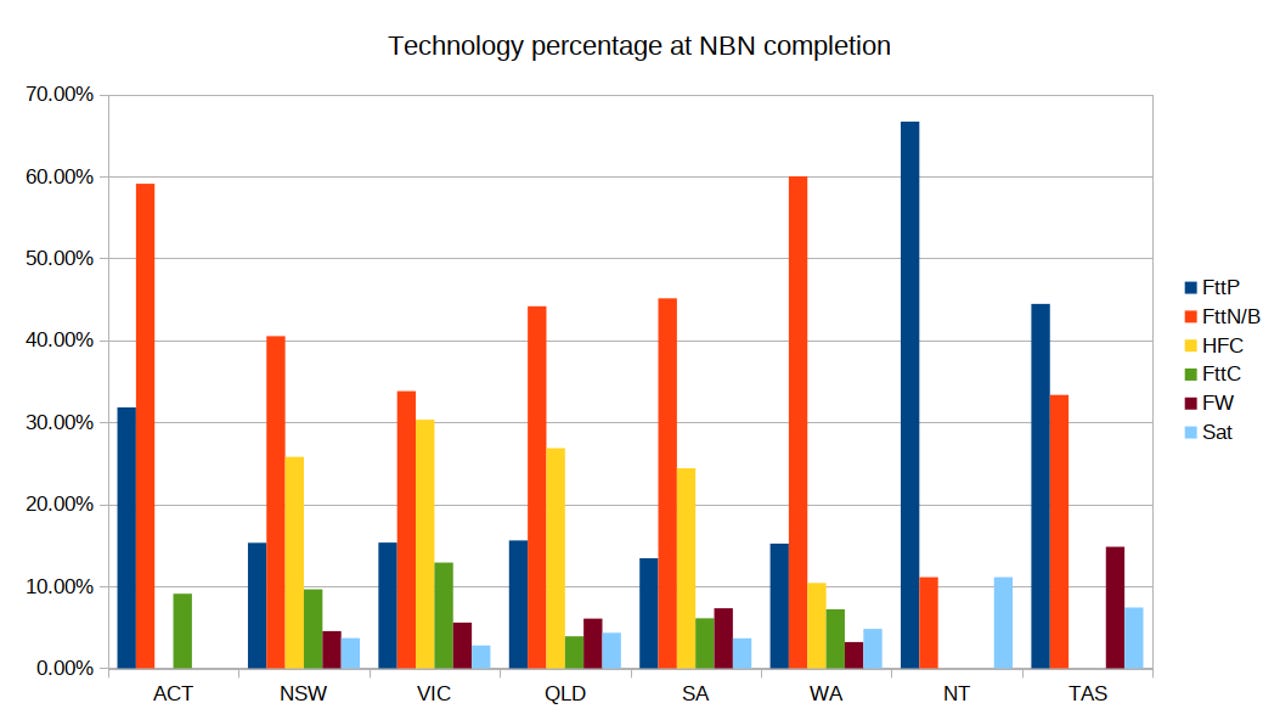Want the best chance of a fibre NBN connection? Move to croc country


Within Australia, there is only one state or territory where the majority of premises will be on fibre to the premise (FttP) at the completion of the rollout, and that lucky place is the Northern Territory.
According to figures up to October 20 provided to the Senate by the company responsible for deploying the National Broadband Network across Australia, the NT is followed by Tasmania, the ACT, Queensland, Victoria, New South Wales, Western Australia, and South Australia.
It is worth keeping in mind that NBN figures are a lot like chasing shadows, particularly the upcoming elements yet to be built, but there are a number of conclusions that can be drawn.
- In the top four populous states of NSW, Victoria, Queensland, and Western Australia, there will be a roughly 15 percent chance of picking a premises at random and finding out it is served by FttP.
- Even though Tasmania was originally meant to be the first state completed with the highest full fibre percent, around only a third of the population will end up on fibre to the node (FttN) or fibre to the basement (FttB).
- The non-fibre connection types, fixed wireless and satellite are pretty close to done, with NBN calling Tasmania and Northern Territory rollouts "essentially complete".
- Western Australia really gets the rough end of the pineapple, with around three in five premises set to have FttN/FttB.
In response to another Question on Notice, NBN revealed that 43 percent of premises in its hybrid fibre-coaxial (HFC) network required a new lead-in, and the company has had to make 232,207 new lead-ins as of November 17.
The company also said it found 6 percent of lead-ins were not fit for purpose.
Under the current NBN Corporate Plan, 1.9 million, or 17 percent of premises, will be covered by FttP; 5.6 million, or 48 percent, by FttN, FttB, and FttC; 3.1 million, or 27 percent, by HFC; and 1 million, or 8 percent, by satellite and fixed wireless.
Technology choice program reflects real world costs: Turnbull
Speaking in Question Time on Tuesday, Prime Minister and former Minister for Communications Malcolm Turnbull said the costs that NBN charges to upgrade connections to a better technology are based in reality.
"In terms of the prices quoted by NBN under technology choice, they simply reflect the real world costs of rolling out more expensive technologies to a particular premise," he said.
NBN's technology choice program has seen one person pay more than AU$200,000 to have their fixed-wireless connection replaced with full fibre.
"A single end user applying for a technology choice upgrade will typically pay a significant amount, particularly if theirs is the first request in the area," NBN said in August.
"In order to provision an FttP service for one end user, significant, complex work is often required at the exchange in order to transmit an FttP service. As a result, the most effective way to lower the price for a tech choice switch would be to aggregate demand amongst multiple end users in the same area."
The highest figure provided in a quote for the switch from fibre to the node (FttN) to FttP was AU$149,937 for a single premises in Katoomba, New South Wales -- with the quote declined by the applicant.
Turnbull was answering questions on Tuesday based on information revealed in Senate Estimates that his mansion in Point Piper and the official residence of the Prime Minister in Sydney, Kirribilli House, had been hooked up to the NBN.
According to representatives of the Department of Prime Minister and Cabinet, both premises have been hooked up with 100/40Mbps plans delivered over HFC, while the official PM residence in Canberra, The Lodge, will be hooked up with fibre to the curb during the third quarter of the year.
That a prime minister selected the fastest plan commonly available would not be remarkable, except that it has been almost eight years since Turnbull said most of Australia does not want 100Mbps.
"The reality is, there simply isn't demand at the household and every small business level for internet at that speed, at a price which would make it even remotely financially viable," Turnbull said in August 2010.
Turnbull said the market for universal 100Mbps fibre internet was not there, but that there was explosive demand for wireless broadband, at which point he held up his iPad.
Related Coverage
ACCC chair warns NBN retailers of 'further interventions'
Consumer broadband issues will be a major ACCC focus this year, with the Chair Rod Sims saying the watchdog will continue focusing on NBN speed advertising.
South Australian Labor to expand fibre broadband if re-elected
A re-elected South Australian Labor government will invest AU$35 million in expanding its GigCity fibre broadband network, and will create a Department of Digital Innovation.
5G will complement NBN, not replace it: Nokia
5G will not replace Australia's NBN, according to Nokia's head of Fixed Networks, as fixed-line technology upgrade paths will enable faster speeds sooner than wireless, and with greater download allowances.
NBN looks to buy 5G spectrum, hesitates on 100Mbps fixed-wireless: Morrow
NBN is 'studying and watching' this year's 5G spectrum auction closely as it would like to obtain part of it, CEO Bill Morrow has told ZDNet, at the same time revealing that the company is hesitating on how it can offer its promised 100Mbps fixed-wireless product without impacting peak period customer experience.
Ericsson CEO says '5G is open for business' at MWC 2018 (TechRepublic)
Early adopters of 5G will likely see increased revenue and improved customer experience, according to Ericsson CEO Börje Ekholm.
'World's first' 5G call completed by Vodafone and Huawei (TechRepublic)
The firms completed the call using the new 3GPP 5G standard.